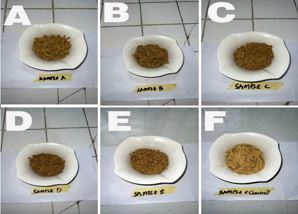Chemical, Microbial, and Sensory Properties of Breakfast Cereals Made from Yellow Maize and Soybean Flour Blends with Firmly Ripe Banana Flavoring
DOI:
https://doi.org/10.54117/ijnfs.v3i3.55Keywords:
Breakfast Cereals, yellow maize, soybean, firmly ripe banana, composite flourAbstract
This study formulated breakfast cereals by combining yellow maize, soybean, and ripe banana flours to enhance nutritional and sensory properties Composite flour was formulated by mixing yellow maize flour and soybean flour in a 70:30 ratio. Five samples of breakfast cereals were then produced by blending the composite flour with banana flour at varying ratios: 95:5 (Sample A), 90:10 (Sample B), 85:15 (Sample C), 80:20 (Sample D), and 75:25 (Sample E). A control sample was also produced, consisting of 100% of the yellow maize and soybean composite flour in the 70:30 ratio without banana flour. The samples were evaluated to determine proximate composition, mineral and vitamin content, microbial and sensory qualities. Results of moisture content of breakfast cereals ranged from 3.41 to 3.61%. Protein and lipid decrease significantly (P<0.05) from 12.65 to 9.31% and 9.94 to 3.61% with increasing ripe banana flour substitution respectively. Fibre and carbohydrate content of breakfast cereal increased significantly (P<0.05) with increase in banana flour from 2.90 to 4.53% and 53.92 to 75.77% respectively. Energy value of the cereal decreased (382.76- 372.85 kcal/100g) with increasing addition of ripe banana flour in the composite blends. For mineral content, there was a significant difference (P<0.05) among the samples. Sample E (75:25) had the highest value in potassium (233 mg/100g). The highest content of magnesium was observed in sample D, E and F (43mg/100g). Vitamin A content of breakfast cereal decreases significantly (P<0.05) from 7.8 to 2.1 mg/100g with increase in ripe banana flour. Vitamin C content increases significantly (P<0.05) from 1.84 to 5.17 mg/100g with increase in ripe banana flour. Microbial analysis revealed the following ranges: Bacteria count, 1.26x105 – 5.00x104 Cfu/g, fungi count, 0.0x104 – 1.0x104 Cfu/g. In sensory evaluation, breakfast cereals served dry and with milk, indicated that sample F and sample A had the highest level of acceptability (7.00), (6.91) respectively among other samples. These results suggest that incorporating ripe banana flour into yellow maize and soybean-based cereals can modify their nutritional and sensory attributes, offering a potentially healthier and palatable breakfast option.

Downloads
Published
How to Cite
Issue
Section
License
Copyright (c) 2024 Anne P. Edima-Nyah, Kingdom E. Ekanem, Victor E. Ntukidem, Chinaemenma V. Ogbonna

This work is licensed under a Creative Commons Attribution 4.0 International License.
